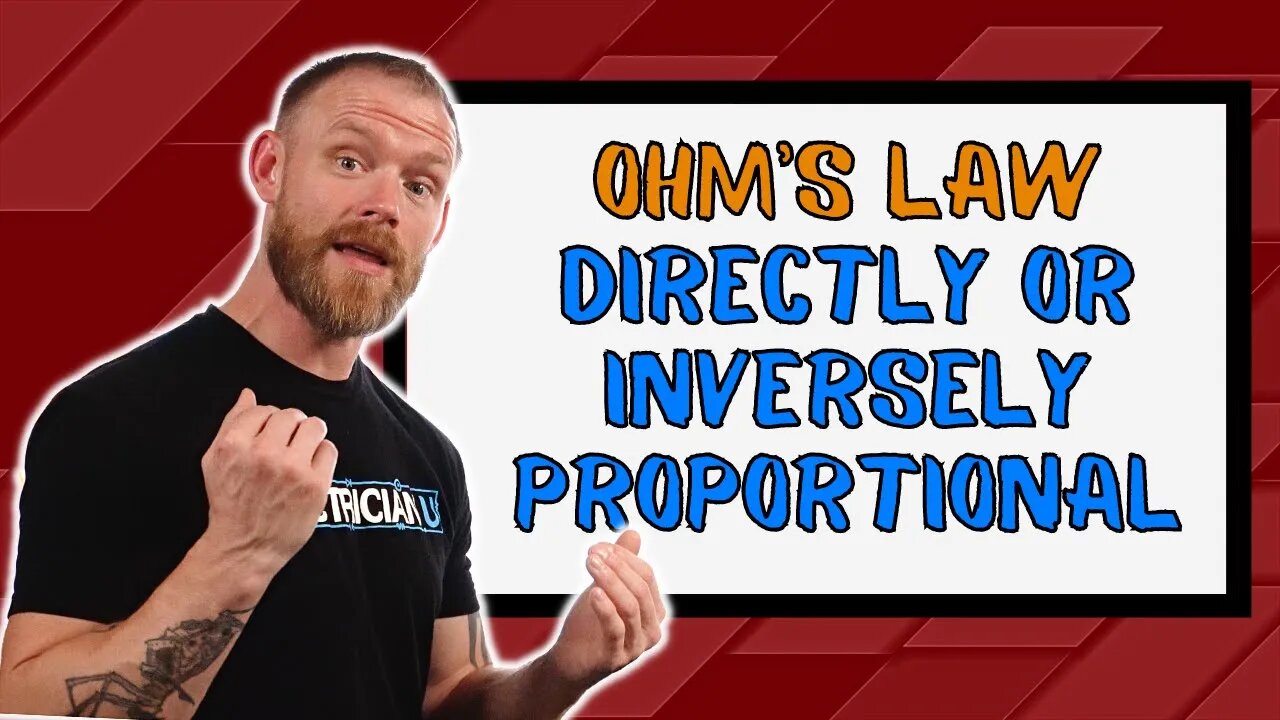Premium Only Content

Ohms Law - Directly vs Inversely Proportional - For Electricians
Ohm’s Law. Something that us electricians use on almost a daily basis to perform our tasks. But that doesn’t mean that it is all easily understood. In this latest episode, Dustin again answers our viewers questions regarding this and sheds some light on the subject.
🤘⚡️MEMBERSHIP⚡️🤘
JOIN ELECTRICIAN U - become a member and get:
FREE Continuing Education every year
FREE Practice Exams
FREE Monthly Video Courses
FREE Weekly Live Instructor-Led Classes
FREE Monthly Educational Newsletter
Premium Members-Only Content
Private Discord Channel
Monthly Members-Only Discord Chats
Sign up here --- https://www.electricianu.com/electrician-u-membership/
🎧🎹MUSIC AND VIDEO:🎹🎧
https://www.facebook.com/descantmv
🎬✍️ART AND ILLUSTRATION:✍️🎬
https://www.daverussoart.com
The question came from the viewer as- Voltage and Amperage Directly Proportional to each other and Resistance is Indirectly Proportional to Current. So how exactly does that all work together?
Well, Directly Proportional means that if you were to raise one value, the other directly proportional item would also go up. Indirectly Proportional means that if you were to raise one value, the indirectly proportional item would go down. Voltage and amperage are directly proportional to each other, so if you were to raise the value of the voltage, the amperage would also go up.
Dustin also does a good job of explaining how to use the 3 value Ohm’s Wheel (Volts, Amps & Resistance). If you draw the wheel with the Volts on top, Amps on the bottom left, and Resistance on the bottom right, all you have to do is cover up the value of the one you are trying to find and perform the equation with what’s left. So, if you were looking for Amps you would need to divide Voltage by Resistance (I=E/R). If you were looking for Resistance you would divide Voltage by Amps (R= E/I).
For example, if you had something that was being powered by 120v and the item had 10 Ohms of resistance, that would result in that item drawing 12a worth of current. We can check the proportionality of the two by raising one of the values and recalculating. So, say we changed the voltage to 240v and kept the 10 Ohms worth of resistance, we can see that amperage changes to 24a. This means that Amperage and Voltage are directly proportional. Change one either up or down, and the other changes up or down with it.
Let’s check the indirect proportionality of Resistance and Current. If we had something operating at 240v and was drawing 5a worth of current the Resistance would be 48 Ohms. If we were to change the current to 15a and leave the voltage at 240v, the result would be 16 Ohms of resistance. This tells us that Current and Resistance are Indirectly Proportional to one another. If you raise one up or down, the other does the opposite of what you did with the first value.
Please continue to follow Dustin Stelzer and Electrician U! Also, don’t forget to send in your questions so Dustin can get you the answers you are looking for!
0:51 - Ohms law
1:24 - Examples Break Down
2:40 - Resistance example
5:28 - Inversely proportional example
#electrician #electrical #electricity
-
 0:56
0:56
Electrician U
1 year ago90° Drill Attachment!!! - What Hand Tools Are YOU Missing
5.58K1 -
 LIVE
LIVE
The StoneZONE with Roger Stone
1 hour agoRoger Stone Destroys Mike Pence for Attacks on Trump | The StoneZONE
1,423 watching -
 1:33:39
1:33:39
Redacted News
5 hours agoBREAKING! Europe goes NUCLEAR against Trump over pushing for PEACE in Ukraine | Redacted
117K152 -
 LIVE
LIVE
Melonie Mac
6 hours agoGo Boom Live Ep 38!
248 watching -
 1:41:00
1:41:00
Darkhorse Podcast
7 hours agoIf Only We’d Known: The 265th Evolutionary Lens with Bret Weinstein and Heather Heying
76.7K31 -
 LIVE
LIVE
Conspiracy Pilled
3 days agoThe Vaccine Conversation (S5 - Ep17)
319 watching -
 11:22
11:22
Tundra Tactical
3 hours ago $1.24 earnedUSA vs Canada HOCKEY Fight: The Real PRIDE Fighting.
25.3K -
 54:43
54:43
LFA TV
1 day agoWhy Exposing Waste and Fraud Terrifies the Beltway | TRUMPET DAILY 2.19.25 7PM
22.7K2 -
 1:01:13
1:01:13
Candace Show Podcast
5 hours agoBlake Lively's BOMBSHELL Legal Filing | Candace Ep 149
93.5K112 -
 1:11:22
1:11:22
Vigilant News Network
8 hours agoElon Musk Shuts Down RFK Jr. Critics With One Powerful Statement | The Daily Dose
65.2K24